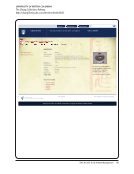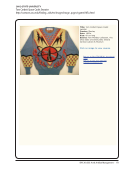72 · Representative Documents: Collection Development Policies
Library of Congress
Collections Policy Statement. Fine and Applied Arts—Non Book Materials (Graphic Arts)
http://www.loc.gov/acq/devpol/fartnonb.pdf
documentary to fine art works, the areas of topical strength in the graphic arts collections are:
the history of American architecture fine and popular arts the history of graphic design and
communication prominent artists documentary aspects of American politics and government,
cultural events and social movements and the history of propaganda and political art.
In its capacity as an international research library, the Library collects prints and drawings that
support the Library’s area studies collections and document subjects of global and international
interests foreign events, individuals and trends impacting or affecting American history,
achievements and concerns and provide insight on matters of American interests, influence
and concern abroad.
III. Collecting Policy
A. Fine prints
1. The Library of Congress selectively acquires artists’ original woodcuts, engravings, etchings,
lithographs, and other types of original prints of the highest caliber that build upon and
complement strengths or fill important gaps in the Library's existing Fine Prints Collection.
Single works as well as prints in collections, groups, and series (including artists’ portfolios) are
collected. Every effort is made not to duplicate the acquisition efforts of other local
institutions.
2. International in scope, the Library’s Fine Prints Collection includes works created from the
15th century to the present day with particular emphasis on prints produced in the United
States since 1870. In special instances efforts may be made to acquire the complete oeuvre of
printmakers for whom the Library’s holdings are particularly outstanding, e.g., American
printmaker and illustrator Joseph Pennell (1857-1926), American architect turned printmaker
John Taylor Arms (1887-1953), and African-American printmaker and founder of the
Printmaking Workshop Robert Blackburn (1920-2003).
3.Comparable to its efforts to collect non-visual works of creative prose, poetry, and music, the
Library seeks to include in its collections artists’ prints that compellingly blend artistry,
technique, and subject matter. Visual content can include representational, figurative, and/or
abstract imagery. Primacy is given to artists, subjects, and art movements that have had or
potentially will have an impact on printmaking in the United States.
4. Acquisitions of foreign fine art prints seek to support research collections and interests of
the Library's Area Studies divisions and build on such extant strengths as prints by Japanese,
European, and Central and South American creators.
5. Current or growing strengths include works by a diversity of American creators including
African American, Latino (including Chicano), and women artists, particularly working in or
after the 20th century. Contemporary prints have been actively collected from the 1930s
forward. Among notable artists for whom the Library has substantial holdings are Albrecht
Dürer (German, 1471-1528), Rembrandt Harmenszoon van Rijn (Dutch, 1606-1669), James
McNeill Whistler (American but based in England, 1834-1903), Mary Cassatt (American born, but
based in France, 1844-1926), Joseph Pennell (American,1857-1926) ,George Bellows (American,
1882-1925), John Taylor Arms (American, 1887-1953), Reginald Marsh (American, 1898-1954),
and Robert Blackburn (American, 1920-2003). Notable subject strengths include Italian
Renaissance and Baroque chiaroscuro woodcuts French and British prints American prints,
especially 19th century works, including: Etching Revival, WPA/FAP, African American Harmon
Foundation (1930s and 1940s), Social Realist and American Scene/ Regionalist, Abstract
2
Library of Congress
Collections Policy Statement. Fine and Applied Arts—Non Book Materials (Graphic Arts)
http://www.loc.gov/acq/devpol/fartnonb.pdf
documentary to fine art works, the areas of topical strength in the graphic arts collections are:
the history of American architecture fine and popular arts the history of graphic design and
communication prominent artists documentary aspects of American politics and government,
cultural events and social movements and the history of propaganda and political art.
In its capacity as an international research library, the Library collects prints and drawings that
support the Library’s area studies collections and document subjects of global and international
interests foreign events, individuals and trends impacting or affecting American history,
achievements and concerns and provide insight on matters of American interests, influence
and concern abroad.
III. Collecting Policy
A. Fine prints
1. The Library of Congress selectively acquires artists’ original woodcuts, engravings, etchings,
lithographs, and other types of original prints of the highest caliber that build upon and
complement strengths or fill important gaps in the Library's existing Fine Prints Collection.
Single works as well as prints in collections, groups, and series (including artists’ portfolios) are
collected. Every effort is made not to duplicate the acquisition efforts of other local
institutions.
2. International in scope, the Library’s Fine Prints Collection includes works created from the
15th century to the present day with particular emphasis on prints produced in the United
States since 1870. In special instances efforts may be made to acquire the complete oeuvre of
printmakers for whom the Library’s holdings are particularly outstanding, e.g., American
printmaker and illustrator Joseph Pennell (1857-1926), American architect turned printmaker
John Taylor Arms (1887-1953), and African-American printmaker and founder of the
Printmaking Workshop Robert Blackburn (1920-2003).
3.Comparable to its efforts to collect non-visual works of creative prose, poetry, and music, the
Library seeks to include in its collections artists’ prints that compellingly blend artistry,
technique, and subject matter. Visual content can include representational, figurative, and/or
abstract imagery. Primacy is given to artists, subjects, and art movements that have had or
potentially will have an impact on printmaking in the United States.
4. Acquisitions of foreign fine art prints seek to support research collections and interests of
the Library's Area Studies divisions and build on such extant strengths as prints by Japanese,
European, and Central and South American creators.
5. Current or growing strengths include works by a diversity of American creators including
African American, Latino (including Chicano), and women artists, particularly working in or
after the 20th century. Contemporary prints have been actively collected from the 1930s
forward. Among notable artists for whom the Library has substantial holdings are Albrecht
Dürer (German, 1471-1528), Rembrandt Harmenszoon van Rijn (Dutch, 1606-1669), James
McNeill Whistler (American but based in England, 1834-1903), Mary Cassatt (American born, but
based in France, 1844-1926), Joseph Pennell (American,1857-1926) ,George Bellows (American,
1882-1925), John Taylor Arms (American, 1887-1953), Reginald Marsh (American, 1898-1954),
and Robert Blackburn (American, 1920-2003). Notable subject strengths include Italian
Renaissance and Baroque chiaroscuro woodcuts French and British prints American prints,
especially 19th century works, including: Etching Revival, WPA/FAP, African American Harmon
Foundation (1930s and 1940s), Social Realist and American Scene/ Regionalist, Abstract
2


















































































































































































